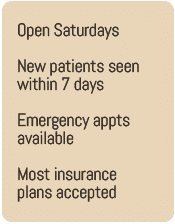The Top 5 Health Problems in the U.S. and Prevention Tips
Prioritizing your health is more important than ever. People in the U.S. are facing a growing health crisis as rates of diseases continue to rise. Many of these diseases are preventable with lifestyle changes and early intervention. In our latest blog, we explore the top 5 health problems in the U.S. and prevention tips.
Heart disease
Heart disease is the leading cause of death in the U.S. Nearly 860,000 Americans die of cardiovascular disease each year. The most common form of heart disease is coronary artery disease (CAD). CAD can lead to heart attacks because it decreases blood flow to the heart.
Other conditions that fall in the heart disease category are arrhythmia, an irregular heartbeat, and heart failure. Heart failure can occur when the heart cannot pump enough blood into the body. Heart failure affects about 6.2 million adults in the U.S., according to the Centers for Disease Control.
Smoking tobacco, high blood pressure, high cholesterol, obesity and a sedentary lifestyle are all risk factors for developing heart disease. Reduce your risk of developing this disease by:
- Maintaining a healthy diet of fruits, vegetables, whole grains and lean proteins; also, limit your intake of saturated fats, trans fats and sodium
- Engaging in regular physical activity, aiming for at least 150 minutes of moderate or 75 minutes of vigorous exercise per week
- Quitting smoking tobacco and avoiding exposure to secondhand smoke.
Cancer
Cancer is another one of the top 5 health problems and a prevalent disease in the United States. About 39.5 percent of men and women diagnosed at some point. There are various types of cancer that affect different organs and systems in the body. The most common forms of cancer are breast, lung, prostate, colon and skin.
Cancer is a genetic disease that results from abnormal cells that grow and divide. You can reduce your risk of developing cancer with these prevention methods.
- Protecting your skin from harmful UV radiation by using sunscreen, wearing protective clothing and avoiding tanning beds
- Maintaining a healthy weight. Obesity is linked to an increased risk of several types of cancer. Aim to achieve and maintain a healthy body weight through a balanced diet and regular exercise
- Participating in recommended cancer screenings, such as mammograms, pap smears and colonoscopies. Early detection can significantly improve treatment outcomes
Chronic lower respiratory disease
Chronic lower respiratory diseases, including chronic obstructive pulmonary disease (COPD), chronic bronchitis and emphysema, can be debilitating and life-threatening. Research has shown that COPD is the fourth leading cause of death in the U.S.
Chronic lower respiratory diseases cause breathing problems when the airways in the lungs become damaged or inflamed. They often become thick with mucus, which can block airflow.
Smoking is a primary cause of chronic lower respiratory diseases like COPD, chronic bronchitis and emphysema. The CDC reports that 38 percent of the nearly 16 million U.S. adults diagnosed with COPD are smokers. Environmental factors like air pollution and exposure at work can also contribute to developing one of these lung diseases.
COPD has no cure, but patients can manage symptoms with medication or by removing pollutants like smoke or secondhand smoke. The biggest factor in preventing a lower respiratory disease is not smoking or stopping smoking if you do. You can also:
- Minimize exposure to air pollution and irritants, especially if you have a history of lung problems
- If you have asthma or COPD, follow your treatment plan by using prescribed medication to manage your condition effectively
Stroke
A stroke occurs when the blood flow to the brain is disrupted. This sudden deprivation of oxygen causes brain cells to start dying, potentially resulting in brain damage or even fatality.
A stroke is considered a major medical emergency, so care is needed immediately. The CDC explains how to identify a stroke and administer care right away, with the acronym F.A.S.T.
- Face: Ask the person to smile and observe if one side of their face is drooping
- Arms: Ask the person to lift both arms and to see if one arm drifts downward
- Speech: Ask the person to repeat a simple phrase and listen for slurred or strange speech
- Time: If you see any of these signs, call 911 right away
Anyone could be at risk of a stroke, but certain factors can increase your chances, including having had a stroke previously. Other risk factors include high blood pressure, high cholesterol, heart disease, diabetes and obesity. You can reduce your risk of stroke by:
- Regularly monitoring your blood pressure. If it is high, take steps to keep it within a healthy range through lifestyle changes and medications
- Eating a diet low in saturated and trans fats, salt and added sugars, which decreases your risk of heart disease
- Avoiding smoking and excessive alcohol consumption
- Staying physically active with at least 150 minutes of moderate-intensity exercise per week
Type 2 diabetes
Type 2 diabetes is a chronic disease that disrupts the production of insulin, the hormone that regulates blood sugar. The CDC reports that over 37 million people in the U.S. have diabetes, and nearly 95 percent have type 2 diabetes.
The cause of type 2 diabetes is usually poor lifestyle choices in diet and exercise. However, people can work to prevent or effectively manage the disease with the right changes. Like many other health conditions, you can reduce your risk by:
- Losing excess weight and maintaining a healthy body weight
- Making healthy nutrition choices and limiting sugary beverages and processed foods in your diet
- Exercise regularly, which helps your body use insulin more effectively
Primary care providers treating the top 5 health problems
The top five health problems in the U.S. can be prevented. The primary care providers at Personalized Hematology-Oncology & Primary Care are your partners in preventing disease. We can provide you with healthy lifestyle tips, disease screening services and risk assessments. Contact our office for an appointment today.





